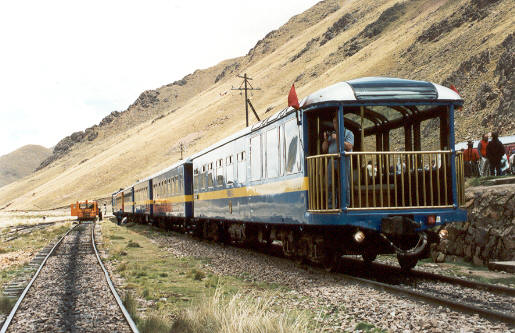19 November 2002: Puno, Peru
Subject: Peru
Trainspotting Peruvian Style
No not Trainspotting the film (we went to see it in Lima, with an audience of five, and I really wonder what the others thought of it) - I mean two of the world's highest altitude and scenic train journeys which we've done over the last few days.
Peru Rail operates the recently-privatised Peruvian rail network. They're geared up mostly for tourists and the trains are clean, prompt and yet still fairly cheap. Our first trip was back to Cusco from Machu Pichu, and the second, today, was from Cusco to Puno on the shores of Lake Titicaca.
The line from Machu Pichu to Cusco follows the Urubamba gorge to a point above Ollantytambo, then climbs up a side valley on to the Altiplano, before winding its way down to Cusco. For the first part of the journey the line winds its way between the river and the cliffs, with views down into the churning water to one side and up to snow-capped peaks on the other. We did this bit in the light and it was quite interesting. But once it got dark the excitement dwindled, especially as we knew that the bus to Cusco from Ollantytambo was much quicker. Finally we crossed the watershed and could see the lights of Cusco below us, with the Inca ruins at Sacsaywaman and the Cathedral and Plaza de Armas lit up. But from here it still took another hour to reach the station: the line winds its way back and forth down the hillside, with two switchbacks when the terrain gets too steep. Worth doing, but probably more interesting in daylight!
The Machu Pichu to Cusco line is narrow guage (about two thirds of normal width I guess) so that it can get around the tight bends. Todays's trip from Cusco to Puno was on full size rails because of the easier terrain, and the train was a bit faster. Still it took us nine and a half hours to do the 350-odd kilometers. From Cusco the line follows the city's river downstream for a while until it joins another larger river flowing from the east. It follows this valley all the way to its source at a little over 4300m (Cusco is at about 3300m), crosses a pass and then descends to the shores of Lake Titicaca.
The view for the first part of the journey as we left Cusco was a depressing one of rubbish strewn everywhere. The locals seem happy to tip their rubbish anywhere, especially if there is a slope to help it roll away such as a river bank. When the rivers are in spate they spread the stuff downstream, and plastic bags and mostly bottles decorate the river's banks, gravel bars and adjacent fields and streets for miles.
Eventually we climbed above this detritus into the uplands: a wide valley full of wet grassland grazed mostly by sheep and alpacas, with some crops growing on the drier areas and up the hillsides. The mountains in the distance looked about another thousand metres high, and at the top some of them had quite a lot of snow on them.
At the very highest point the train stops for a few minutes so that the passengers can get off, take some photos, and perhaps buy something from the locals. They had the usual Peruvian stuff, but rather better jumpers than we have seen elsewhere, so maybe Puno is the place for them. But this point is really very high - at over 4300m, it's higher than we've been so far on this trip and the highest I've been for ten years. We've been above 3000m for nearly a month now and are reasonably aclimitised yet still you notice that you need to take more breaths. One of the passengers presumably hadn't had as long to get used to the lack of oxygen and collapsed amongst the jumpers and toy lamas. They gave him oxygen and sent him off to hospital at a slightly lower altitude and we hear that he is recovering.

So from the summit the line descends to about 3900m, at which point the valley flattens out: Lake Titicaca has been larger in the past, and the line crosses the ancient lake bed. The last city before Puno is Juliaca, described in most unflattering terms in our guidebook; the train seems to go down the middle of the main street, barely missing the market stalls on either side. (Juliaca market seems to sell everything you could think of a use for, and plenty of things you couldn't, including whole stalls selling rusty old gear wheels and used car tyres.) Finally the lake becomes visible. Along the edges are small cultivated areas with probably potatos. In the lake itself there are lots of reeds, and I noticed a couple of piles of them on the shore. ¿What are they going to use them for? I asked myself - and the answer was apparent a few seconds later when we saw our first Lake Titicaca Reed Boat. Shortly afterwards we actually saw a boy punting one of them out by the reeds. They have wooden boats too, but the reed boats realy seem to still be in use.
So now we've arrived in Puno, the main town on the Peruvian side of the lake. It's main tourist attraction is the boat that was famously made in Glasgow and brought up from the pacific in 2000-odd pieces by mule. Then we have to decide which of the islands to visit. We don't really know what we're going to do next, but we're glad to have finally left Cusco!